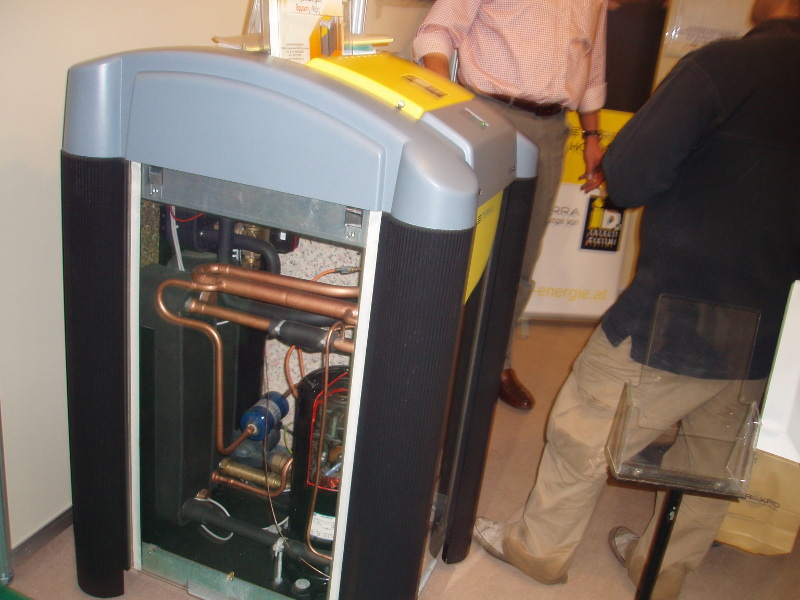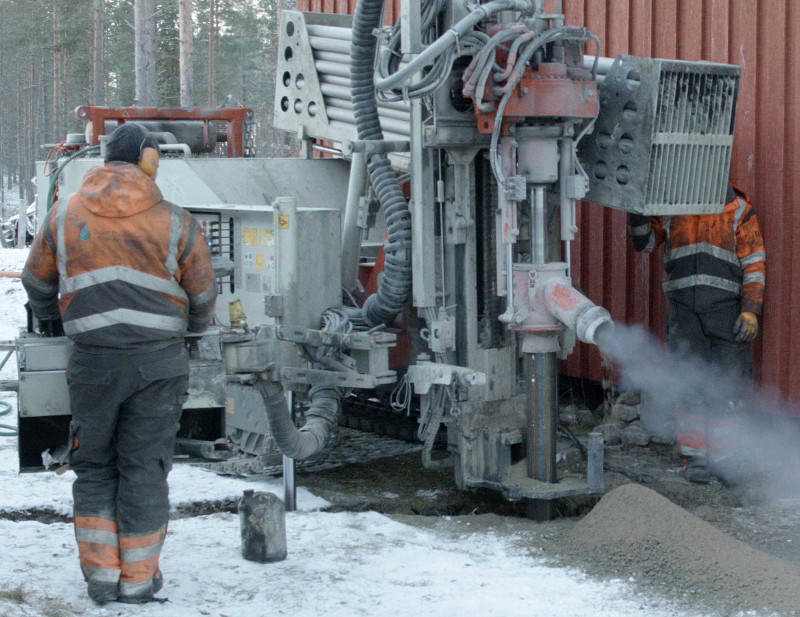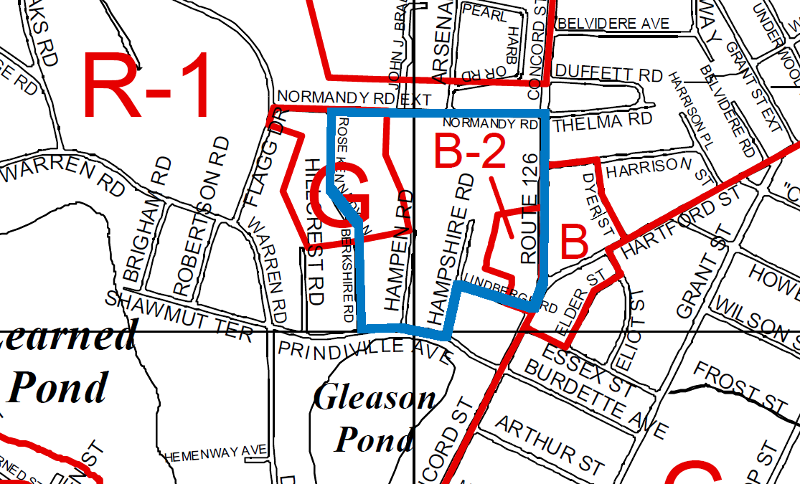Geothermal Pilot Project in Framingham Could Have Broad Impact on Rental Heating and Cooling
| . Posted in News - 0 Comments
By Eric Weld, MassLandlords, Inc
If a three-year geothermal pilot project being launched this year in the city of Framingham is successful, it could dramatically shift urban energy commerce, consumption and infrastructure well into the future.

A geothermal heat pump has three components. Antifreeze runs through plastic pipes in the ground (not shown) to collect or deposit heat. Refrigerant runs in copper pipes to pull that heat out of the antifreeze. An air handler (not shown) then heats the premises through ducting. Geothermal heat pumps to baseboard are possible, too, although at time of writing less frequently commercially available. CC BY-SA 4-0 Tzeferis Petros.
A pilot coordinated by Eversource, New England’s largest electricity and natural gas utility, will use the earth’s heat to warm buildings in winter. The process reverses in summer, drawing heat out of buildings to cool them and pumping it back into the ground. The project is the first of its kind in the state.
In the short term, the geothermal pilot program seeks to devise a sustainable, renewable heating/cooling alternative to burning fuels like gas and oil, or using electricity for those functions, while potentially cutting costs for customers.
In the long term, the pilot would ideally create a model for other urban areas for converting inefficient gas-burning systems to geothermal systems for residential and commercial customers at scale.
Terminology: “Geothermal” vs. “Ground Source Heat Pump” (GSHP)
Before we continue, it’s important to explain our use of terminology. The Eversource pilot will utilize a series of ground source heat pumps (GSHPs), which draw heat from just beneath the earth’s surface, where it remains a steady 50 to 60 degrees Fahrenheit throughout the year. Eversource refers to the Framingham pilot as a geothermal energy project. Etymologically, this is a correct term, as the combination of “geo” – of or relating to earth – and “thermal” – of or relating to heat – entails the process used to exchange heat with the earth.
“Geothermal” has traditionally been used to describe electricity generation on an industrial scale, at power plants that tap into the earth’s crust and magma to heat water, creating steam that can drive turbines for producing electric power. This is a process distinct from that used by ground source heat pumps.
The terms “geothermal” and “ground source heat pump” energy are often used interchangeably, while some within the energy industry insist on maintaining a distinction between these two different warming methods. Because Eversource refers to its Framingham pilot as a “geothermal” project, and that terminology has been adopted by other media, we will remain consistent with that usage. (MassLandlords members searching online for home-based “ground source heat pump” products or information are advised to use that terminology, though searches for “geothermal” may also yield valuable insight.)
Geothermal Neighborhood
For the Framingham project, Eversource will begin construction this year on a series of piping, wells and air pumps in the neighborhood of Concord Street. The company is inviting its gas utility customers to participate in the program and will subsidize investments in heat pumps and other equipment.
The city of Framingham was chosen for the pilot because of its mix of residential and commercial buildings, diversity of income levels and heating/cooling utilities being used, and favorable geological conditions locally that facilitate such a project, according to Shawn Luz, sustainability coordinator for the city.
“Another critical element of Framingham being selected was the strong community support for clean energy and especially the geothermal pilot program,” Luz told MassLandlords. “Framingham’s participation in the pilot aligns with a number of initiatives that we have underway to support residents and businesses, reduce the community’s carbon footprint and promote the local development of clean energy and energy efficiency technologies.”
Among those initiatives, Luz said, is the city’s participation as a member of the state Department of Energy Resources’ Green Communities Program, which helps municipalities cut energy use and costs through local green projects in schools, facilities and other buildings.
The Eversource pilot will service 45 buildings in and around Concord Street, about 30 of them residences.
Eversource will monitor results of the pilot and participating customers’ experiences through two heating-cooling seasons (about three years total), said Luz, to determine outcomes such as cost-effectiveness and efficiency.

Drilling of a borehole for residential geothermal heating in Northern Finland. Geothermal is an ideal winter heating option because the ground is constantly warm. The rack of tubes is full of drill extenders. Well depths for Massachusetts measure in the hundreds of feet. Public Domain Olli Niemitalo.
Measure of Success
In order to succeed, the pilot will depend on enlisting enough residential and commercial participants to sufficiently share costs of initial infrastructure investments and ongoing costs for system maintenance and power. The largest costs associated with geothermal power conversion of this type are excavation of roads and walkways and installation of underground piping.
Eversource is investing $10.2 million in the pilot project. Construction will consist of drilling wells, installing main and T-intersection pipes for individual access, and installing pump systems in participating homes and buildings.
Eversource representatives have reached out to the Framingham community this year through municipal briefings, information sharing at community events, door-to-door visits and virtual and in-person meetings. If you are a Framingham resident or business seeking more information on the geothermal pilot, contact Eversource at geothermal@eversource.com.
Customers participating in the pilot will use geothermal heated and cooled air for the duration of the program. They will pay a fixed monthly charge for the geothermal heating and cooling service and provide feedback to Eversource.
The utility will pay for construction and installation costs, as well as equipment in customers’ homes and businesses.
Geothermal Basics
Ground source heat pump (geothermal) systems transfer a fluid (sometimes refrigerant in copper pipes, but usually antifreeze in plastic pipes) to a level below the underground frost line, where temperatures remain close to 50 degrees year-round. The pump system uses a series of coils to move heat in or out of homes, depending on the season, via refrigerant fluid.
In winter, the coils absorb warmth from the ground loop and heat is distributed to a house or business using a heat exchanger. During warm seasons, the pump works in reverse, removing heat from buildings and depositing it in the ground loop for natural cooling.
Geothermal systems use much less electricity to operate than traditional HVAC systems, because no energy is needed to heat or cool the air – that takes place naturally underground. Only the pump, fan and compressor use electricity, making for more efficient and cost-effective systems in the long run. About one-third to a quarter of energy used for heating and cooling through a geothermal system comes from electricity.

The proposed geothermal distribution network is a loop cutting through four types of land use: R-1, G, B and B-2. In Framingham’s zoning code, this corresponds to residential single family, gentle density brick townhouse, business, and community business. This gives the pilot a variety of heating and cooling systems to work with, as well as a variety of local concerns and receptivities to learn about. The proximity to Gleason Pond appears to be circumstantial. Although some geothermal systems obtain high heat transfer rates by looping through surface water, Gleason Pond’s average depth (3’) may be too shallow to prevent winter freezing. Public domain zoning map.
Geothermal for Landlords
If the Framingham geothermal project proves successful, it could change the equation for heating and cooling costs for property owners and renters. Once up and running, geothermal systems can save up to 70% annually on energy bills. If an average apartment costs more than $900 per year to heat and cool, 70% translates to $630 saved per year.
Electricity bills for geothermal systems are expected to increase during cold months, but that increase is more than offset by savings from not having to purchase heating fuel or electrical resistance service. The overall efficiency of a geothermal system should result in lower annual energy costs.
The steepest costs for geothermal are for system installation. Upfront costs can run between $10,000 and $40,000, depending on the type of system.
But neighborhood-wide infrastructures such as that in the Framingham pilot may become a model due to their efficiency and shared cost. Where costs to install geothermal heating and cooling systems can be prohibitively high for a single property, creating a series of piping and pumps such as that on Concord Street disburses the costs over multiple users, making it more manageable for users while ensuring customer volume to help offset the utility’s investment.
Especially in cases such as Framingham, in which the utility company subsidizes up-front installation costs, customers may benefit appreciably.
Global Geothermal
Geothermal energy, despite recent upticks in popularity, is not a new technology. In fact, in general, it’s among the oldest forms of energy on earth. For example, it’s been used for at least 10,000 years by people gathering near and tapping the warming effects of natural hot springs. Ancient Romans harnessed geothermal energy to heat buildings.
The United States began producing geothermal power on a large scale after World War II, and opened the world’s largest geothermal power plant complex, The Geysers, north of San Francisco, in 1960. The U.S. remains the top producer of geothermal electricity generation, producing 16.7 billion kilowatt hours (kWh) of geothermal energy per year as of 2018. Geothermal and ground source energy is now used in several countries, including New Zealand, El Salvador, Kenya, the Philippines, and for around 90% of home heating demand in Iceland.
Massachusetts is a top state in terms of overall energy options, but falls low on the list of geothermal energy production in comparison with western states, which have closer subsurface proximity to natural geothermal resources such as hot springs and geysers.
Still, low temperature ground source theoretically works everywhere, and the Bay State hosts several geothermal (GSHP) energy companies. Also, National Grid is conducting its own geothermal project in the state similar to the Eversource project, testing the viability of shared, district-based geothermal systems.
Can Geothermal be Cost-effective?
It’s no secret that heating and cooling energy costs are among the largest expenses for landlords and renters. Heating fuels like natural gas and oil increase nearly every year and show no signs of abating. Inflation above 8% in spring-summer of 2022 has pushed these costs through the roof. Meanwhile, the cost of replacing 40% of Boston’s gas pipes, for example, will run the city between $12 billion and $20 billion, pushing costs even higher while not addressing methane pollution from leakage or greenhouse gas reduction.
As landlords look for alternatives to keep their rentals heated, cooled and habitable for tenants, more efficient options like electric heat pumps, solar and geothermal systems continue to gain traction despite high upfront costs.
Even among the slate of alternatives, in New England anyway, geothermal may be the most consistently reliable source for heating and cooling. Solar reliability diminishes considerably in our long, dark winters, and air source heat pump systems will never be as efficient as a system that warms and cools air underground.
While carbon emissions are a foremost consideration in developing geothermal systems, projects like the Framingham-Eversource pilot will need to be cost-effective in order to scale up. This two-season pilot and others will go a long way to determining if regional, shared geothermal energy systems can become a widespread and cost-effective solution for homeowners and renters across the state and perhaps nationally.
For more information on Framingham geothermal, contact Eversource.




